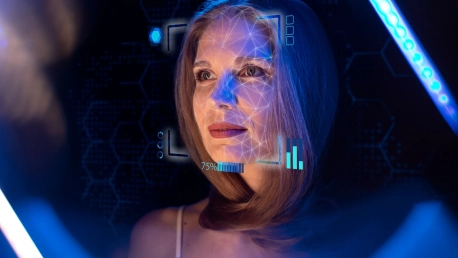AI-powered deepfake technology signifies a considerable advancement in artificial intelligence, combining “deep learning” and “fake” to create highly realistic media that can mimic real individuals. While the entertainment industry sees potential, the same technology raises significant ethical and security challenges. This article delves into the workings of deepfake technology, explores its wide-ranging applications, and examines the critical issues related to its misuse. Additionally, it highlights the development of deepfake detection technology and its role in mitigating potential risks, thereby providing a balanced perspective on these advanced technologies.
What is AI-Powered Deepfake Technology?
How Deepfakes Work
Deepfake technology relies on substantial datasets of the target individual, gathering various images, videos, and audio recordings. Advanced deep learning models, particularly Generative Adversarial Networks (GANs), are integral to this process. GANs consist of two neural networks: the generator, which creates fake content, and the discriminator, which evaluates the authenticity of that content. During training, these models progressively improve as the generator attempts to create convincing fakes while the discriminator tries to detect them. This iterative process enhances the generator’s ability to produce highly realistic media, including facial expressions, voice intonations, and mannerisms that closely mimic the target individual.The sophisticated nature of these algorithms allows for the creation of highly convincing fake media, posing both innovative opportunities and threats. Once trained, these models can generate new content where individuals seem to perform actions or speak words they never actually did. For instance, a deepfake video might depict a public figure delivering a speech they never gave or engaging in activities they never participated in. The potential for misuse becomes apparent when considering how easily such technology can deceive audiences, influencing opinions and behaviors based on fabricated content. The dual-edged nature of deepfakes underscores the necessity for understanding their mechanics and implications.
Applications of Deepfake Technology
The entertainment industry is perhaps the most visible beneficiary of deepfake technology. Filmmakers and video game developers employ deepfakes to create CGI characters that interact seamlessly with real actors. Additionally, actors can be de-aged to fit specific roles, providing creative flexibility without the constraints of traditional makeup and special effects. This technology has revolutionized storytelling, enabling the portrayal of younger versions of actors or even bringing deceased actors back to life for new performances. The blending of reality and fiction through deepfakes has thus opened new vistas for visual storytelling and entertainment.In education and training, deepfake technology offers immersive simulations that enhance learning experiences across various fields. For example, medical students can practice surgical procedures using realistic simulations of patient interactions. Law enforcement and military personnel can also benefit from training scenarios that depict realistic encounters, helping them prepare for real-world situations. These applications demonstrate how deepfakes can serve as valuable educational tools, providing experiential learning opportunities that are both engaging and beneficial.Advertising is another arena where deepfakes have made a significant impact. Personalized advertisements featuring celebrities or influencers are more likely to attract consumer interest and drive sales. By creating highly realistic media, advertisers can customize content to resonate with specific target audiences, enhancing the effectiveness of marketing campaigns. However, while these applications showcase the creative potentials of deepfakes, their misuse demonstrates serious ethical and security concerns. The ability to manipulate appearances and voices without consent raises fundamental questions about privacy, consent, and authenticity.
Effects of AI-Powered Deepfake Technology
Misinformation and Fake News
The capacity to create convincing fake media through deepfakes has far-reaching impacts on public opinion, enabling the spread of misinformation and fake news. These fabricated narratives can infiltrate social media platforms, news websites, and other digital spaces, influencing elections, social movements, and general public sentiment. Deepfakes can depict political leaders making inflammatory statements or engaging in unethical behavior, swaying voters based on false premises. The rapid dissemination of such content can erode trust in legitimate news sources and foster a climate of skepticism and confusion.The proliferation of fake news through deepfakes presents a critical challenge for societies aiming to maintain informed and healthy democracies. The ease with which deepfakes can be produced and shared exacerbates this issue, making it imperative for digital media consumers to remain vigilant. Fact-checking organizations and newsrooms must employ advanced verification techniques to discern authentic content from fabrications. The challenge lies not only in detecting deepfakes but also in addressing their psychological impact on audiences predisposed to believe in conspiracies and false narratives. As such, combating misinformation requires a multi-faceted approach that encompasses technological, educational, and regulatory measures.
Privacy Violations and Security Threats
Manipulating individuals’ faces and voices without consent constitutes a severe invasion of privacy, leading to potential defamation and psychological harm. Deepfakes can be weaponized for personal vendettas, creating compromising or humiliating content that tarnishes reputations and inflicts emotional distress. The unauthorized use of someone’s likeness in defamatory or explicit material raises significant ethical and legal concerns. Current laws often lag behind technology, leaving victims with limited recourse to seek justice and protect their privacy.Moreover, deepfakes pose substantial security threats, as they can be used in sophisticated social engineering attacks. For example, cybercriminals might create deepfake videos or audio recordings of CEOs authorizing fraudulent transactions or making sensitive corporate decisions. These deceptions can infiltrate corporate email systems, convincing employees to transfer funds or disclose confidential information. The financial and reputational damage resulting from such attacks underscores the urgent need for organizations to develop robust security protocols and authentication mechanisms. By understanding the inherent risks associated with deepfakes, companies can better safeguard their assets and maintain stakeholder trust.
Erosion of Trust
The ability to create highly realistic fake media can lead to a general skepticism towards digital content, eroding public trust in media communications. As deepfakes become increasingly sophisticated, distinguishing between genuine and fabricated content becomes more challenging. This blurring of reality and fiction undermines the credibility of legitimate news outlets, social media platforms, and other digital channels. The erosion of trust extends beyond media to affect interpersonal relationships, legal proceedings, and public discourse, creating an environment where authenticity is constantly questioned.In such a landscape, reliable verification mechanisms are essential to maintaining public confidence in digital information. Media literacy programs can educate audiences on the potential for deepfake manipulation, fostering critical thinking skills that help individuals discern credible sources from dubious ones. Additionally, technological solutions must evolve to outpace the capabilities of deepfake creators, providing tools for detecting and authenticating digital content. By prioritizing transparency and accountability, digital platforms and content creators can work towards restoring trust in the age of advanced media manipulation.
AI-Powered Deepfake Detection Technology
How Deepfake Detection Works
Deepfake detection technology employs advanced algorithms designed to identify inconsistencies in media files, meticulously analyzing patterns such as unnatural blinking, lip-sync mismatches, or pixel anomalies that may not align with genuine content. These subtle discrepancies, often imperceptible to the human eye, serve as telltale signs of manipulation. Detection algorithms leverage machine learning to continually improve their accuracy, training on extensive datasets of both real and fake content to recognize even the most sophisticated deepfakes. This machine learning approach enables detection systems to evolve alongside the techniques used to create deepfakes, ensuring they remain effective against emerging threats.Additionally, metadata analysis plays a crucial role in detecting deepfakes. By examining data embedded in media files, such as creation and modification dates, analysts can identify signs of tampering or anomalies that suggest manipulation. For instance, inconsistencies between the metadata and the content’s visual or auditory elements may indicate that the file has been altered. This comprehensive analysis helps in constructing a more accurate picture of the media’s authenticity.Blockchain technology is also being utilized to verify the authenticity and integrity of media files. Blockchain’s decentralized and immutable nature ensures that any changes to a media file are recorded and traceable, providing a transparent history of the content’s origin and modifications. This transparency is critical for establishing trust in digital media, as it allows users and platforms to verify the authenticity of content confidently. By combining pattern recognition, metadata analysis, and blockchain verification, deepfake detection technology offers a multi-layered approach to identifying and countering fake media.
Applications of Deepfake Detection Technology
Social media platforms have integrated deepfake detection tools to identify and remove manipulated content, ensuring the authenticity of shared media and protecting users from misinformation. These platforms employ advanced algorithms to scan images and videos for signs of tampering, flagging suspicious content for further review. By proactively monitoring and filtering deepfakes, social media companies aim to preserve the integrity of their networks and foster a trustworthy online environment. This ongoing effort involves collaboration with researchers, policymakers, and other stakeholders to develop and refine detection capabilities continuously.News organizations also employ deepfake detection technology to verify the legitimacy of sources and content, maintaining journalistic integrity and accuracy. Fact-checking teams use detection tools to scrutinize videos and audio recordings, ensuring that the information disseminated to the public is factual and unaltered. This process not only helps prevent the spread of fake news but also reinforces the credibility of news outlets committed to delivering reliable information. As deepfakes become more prevalent, the role of detection technology in preserving the integrity of journalism cannot be overstated.Legal and regulatory bodies utilize deepfake detection tools in investigations and enforcement of regulations against malicious deepfakes, promoting ethical standards and accountability. By identifying and analyzing manipulated media, these agencies can gather evidence to support legal proceedings, deter malicious actors, and uphold regulatory standards. This application of detection technology is particularly relevant in scenarios involving defamation, fraud, or other criminal activities where deepfakes are used to deceive or cause harm. The ability to detect and respond to deepfakes strengthens the legal framework, ensuring that perpetrators are held accountable and victims receive justice.Businesses are also adopting deepfake detection technologies to guard against fraud and impersonation, bolstering corporate security. By incorporating detection tools into their cybersecurity protocols, companies can protect themselves from social engineering attacks that leverage deepfakes to impersonate executives or breach security measures. This proactive approach not only mitigates financial and reputational risks but also fosters a culture of vigilance and innovation within organizations. As deepfakes become more sophisticated, the integration of detection technology into business operations will be essential for maintaining robust security and trust.
Effects of Deepfake Detection Technology
Enhanced Security and Maintaining Trust
The improved capabilities of deepfake detection technology significantly enhance security, protecting individuals and organizations against identity theft, fraud, and other cybercrimes. By accurately identifying manipulated content, detection tools prevent malicious actors from exploiting deepfakes for financial gain or reputational damage. This heightened security is crucial in an era where digital interactions and transactions are ubiquitous, necessitating reliable methods to authenticate media and safeguard sensitive information.Verifying the authenticity of digital content through detection technology also plays a vital role in maintaining public trust in media and communications. As deepfake incidents become more common, the ability to distinguish genuine content from fabrications helps uphold the credibility of news outlets, social media platforms, and other digital channels. This trust is essential for maintaining informed public discourse, enabling societies to navigate complex issues with confidence in the information they receive. By fostering transparency and accountability, deepfake detection technology contributes to a more secure and trustworthy digital ecosystem.
Regulation and Empowerment
AI-powered deepfake technology represents a major leap forward in artificial intelligence, blending “deep learning” with “fake” to generate exceptionally lifelike media that can imitate real people. This groundbreaking tech offers promising opportunities in the entertainment world, allowing for more realistic special effects and virtual performances. However, it also brings forth substantial ethical and security issues. This discussion delves into how deepfake technology operates, its diverse applications, and scrutinizes the serious concerns linked to its misuse, such as misinformation, identity theft, and privacy violations.Moreover, the article spotlights the advances in deepfake detection technology, which aim to counteract these potential threats. By identifying and flagging fraudulent media, this technology plays a crucial role in mitigating associated risks. Thus, the piece provides a comprehensive and balanced view of deepfake technologies, weighing their innovative benefits against the serious challenges they pose. Deepfake detection methods, such as AI algorithms designed to recognize manipulated media, are becoming increasingly vital in maintaining the integrity and trustworthiness of digital content.









